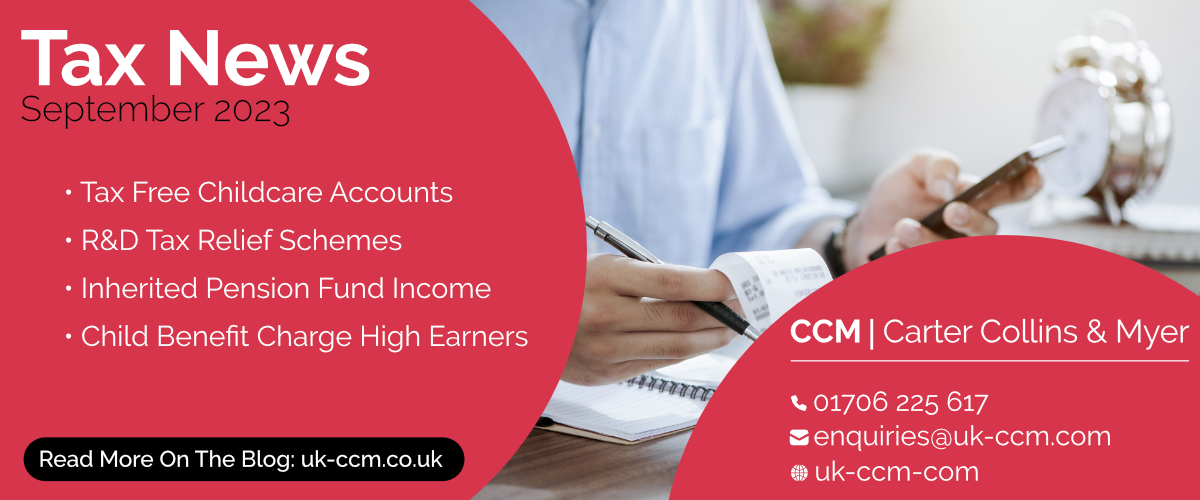Tax News September 23
BACK TO SCHOOL – SET UP A TAX FREE CHILDCARE ACCOUNT?
The Government’s Tax-Free Childcare Accounts provide a 25% subsidy towards the cost of childcare. The account can be used to pay nursery fees, breakfast clubs, after school clubs and registered childminders.
The scheme operates by topping up savings of up to £8,000 per child by 25%, potentially an extra £2,000 a year from the Government to spend on qualifying childcare. The scheme generally applies to children under 12. In the case of disabled children the age limit is 16 and the amount that can be saved is £16,000 a year, topped up by the Government by a further 25% to potentially £20,000.
Unlike childcare vouchers, still provided by some employers, tax free childcare accounts are available to both employees and the self-employed. To be eligible, the parent generally needs to be working and earning at least the National Minimum Wage or National Living Wage for at least 16 hours a week on average. However, parents are not eligible if either of the parents’ adjusted net income is more than £100,000 a year.
Note that where an employer provides Childcare Vouchers then the parents are not allowed to set up a Tax-Free Childcare Account as well. Please contact us for advice on whether or not it would be beneficial to leave your employer’s Childcare Voucher Scheme, noting in particular that the voucher scheme applies to children up to age 16, rather than age 12.
CHILD BENEFIT MAY CREATE A TAX CHARGE FOR THOSE WITH HIGH INCOME
Parents and carers need to be aware that if either of the couple have ‘adjusted net income’ in excess of £50,000 then the one with the higher income will potentially be charged to tax on some or all of the child benefit and will need to request a self-assessment tax return to report the amount of child benefit received in the tax year. The High Income Child Benefit Charge (HICBC) was introduced in 2012/13 and imposes a 1% charge on the amount of child benefit received for every £100 that the taxpayer’s adjusted net income exceeds £50,000. ‘Adjusted net income’ is an individual’s total taxable income before any allowances, but after deducting Gift Aid, pension contributions, and trade union subscriptions.
Where the adjusted net income is £60,000 or more, then 100% of the child benefit is charged, effectively fully clawing back the child benefit. Note that the £50,000 threshold has not been increased since it was introduced in 2012 which means that more and more parents are being caught by the HICBC each year. It has recently been announced that in future years the government plans to deduct HICBC directly from salaries via PAYE. It is possible to opt out of receiving Child Benefit payments where adjusted net income exceeds £60,000. Consequently, the HICBC would not apply and the child benefit would not need to be reported on the tax return. That may mean that a taxpayer who has their tax collected under PAYE would not be required to submit a self-assessment tax return. It is important to still fill in the Child Benefit claim form but state on the form that you do not want to get payments. That is important as the claimant would then receive National Insurance credits for that year, which count towards their State Pension entitlement.
One of the problems with the HICBC is that those taxpayers who pay their tax under PAYE are not normally required to file a self-assessment tax return. However, if they are parents and one of the couple is in receipt of child benefit then they are required to request a self-assessment tax return from HMRC to report the child benefit if their adjusted net income exceeds £50,000 a year. HMRC have started assessing taxpayers to HICBC where they have not reported their child benefit in earlier years. Several taxpayers have successfully
challenged these assessments through the courts in a number of recent tax cases. Whether or not a successful appeal can be made will depend on the circumstances in each case.
MERGER OF R&D TAX RELIEF SCHEMES TO GO AHEAD
The government have issued draft legislation for consultation on the proposal to merge the two forms of corporation tax relief for expenditure on research and development (R&D)
For expenditure incurred on or after 1 April 2024, it is proposed that the two schemes providing for R&D relief - R&D expenditure credit (RDEC) and Credit Relief for SMEs, will be merged and replaced with a single unified scheme. This will operate alongside a new scheme to provide additional relief for “R&D intensive” SME companies.
It is suggested that this merged scheme will operate in a similar manner to the existing RDEC scheme, rather than the SME scheme. The merged scheme will offer a taxable credit, based on a percentage of R&D expenditure, that can be offset against the company’s tax liability. The rate of relief under the proposals is 20% of R&D expenditure. This translates into a net benefit of 15%, assuming a company pays tax at the 25% main rate of corporation tax.
The exception to this would be for loss-making “R&D intensive” SMEs. These companies would be able to continue to claim an additional deduction for R&D expenditure, and where that deduction produces or contributes to a loss, claim a payable credit for that loss.
“R&D Intensive” SME companies
It is envisaged that the current SME relief will effectively continue for loss-making R&D intensive companies. An R&D intensive company is broadly defined as being where R&D expenditure is 40% of the company’s total expenditure for the purposes of calculating profits chargeable to corporation tax. For those companies, the additional deduction will remain at 86%, with the rate of payable credit for surrenderable losses being 14.5%. This would provide a repayable credit of £26.97 for every £100 spent on qualifying R&D.
INCOME TAX ON INHERITED PENSION FUNDS
Currently, where an individual pension holder dies before age 75, drawdown pensions paid to a successor can generally be received free from income tax. Where the pension holder dies over the age of 75, then the amounts drawn by the successor are taxed at their marginal income tax rate. Note also that the current tax rules provide that the value of the fund passes free of inheritance tax to the successor and thus forms an important part of estate planning.
Policy documents published in July 2023 include draft legislation to abolish the pension lifetime allowance and associated income tax charge. These were previously announced as part of Budget Day measures to lure workers aged over 50 back into work and are generally welcomed. However, the policy documents regarding changes to the taxation of pensions also included a suggestion that certain beneficiaries of pensions of members who died under age 75 may become subject to income tax as part of future tax changes, possibly from 2024/25. This would align with the tax position for beneficiaries of pensions where the member dies over age 75.
HOW YOU PAY DIVIDENDS IS CHANGING
If you operate your own Limited Company and receive dividends, this post is intended for you.
Until now, a fair number of you mischievous individuals have been retroactively dating your dividends—essentially withdrawing cash haphazardly throughout the year and then at the year's end, processing a
solitary substantial dividend that covers all the withdrawals made during the year. This is done to ensure that your loan account doesn't end up in a negative balance.
This approach has been effective for a long time, but it opens up a significant opportunity for tax avoidance and what we might call "last-minute adjustments." Her Majesty's Revenue and Customs (HMRC) has grown tired of this practice.
Starting from April 2025, whenever you take money out of your company, it will most likely need to be reported to HMRC along with your monthly salary.
Naturally, these numbers must align with what ultimately appears on your tax return. This means establishing a closer working relationship with your accountant and payroll provider. It's crucial to ensure that we're aware of what you've withdrawn each month, so we can accurately report it to HMRC and help you steer clear of any issues.
There are a few other changes as well, pertaining to additional information that HMRC will be gathering. Take a look at this, and feel free to give me or my colleague Mark a call if you wish to organize your financial matters before these adjustments come into effect.
ADVISORY FUEL RATE FOR COMPANY CARS
The table below sets out the HMRC advisory fuel rates from 1 September 2023. These are the suggested reimbursement rates for employees' private mileage using their company car.
Where the employer does not pay for any fuel for the company car these are the amounts that can be reimbursed in respect of business journeys without the amount being taxable on the employee.

Where there has been a change the previous rate is shown in brackets.
You can also continue to use the previous rates for up to 1 month from the date the new rates apply.
Note that for hybrid cars you must use the petrol or diesel rate. For fully electric vehicles the rate is 10p (9p) per mile.
DIARY OF MAIN TAX EVENTS SEPTEMBER/OCTOBER 2023
- 1 September: Corporation tax for year to 30/11/22 unless paid by quarterly instalments.
- 19 September: PAYE & NIC deductions, and CIS return and tax, for month to 5/9/23 (due 22 September if you pay electronically).
- 1 October: Corporation tax for year to 31/12/22 unless paid by quarterly instalments.
- 5 October: Deadline for notifying HMRC of chargeability for 2022/23 if not within Self-Assessment and receive income or gains on which tax is due.
- 19 October: PAYE & NIC deductions, and CIS return and tax, for month to 5/10/23 (due 22 October if you pay electronically).

